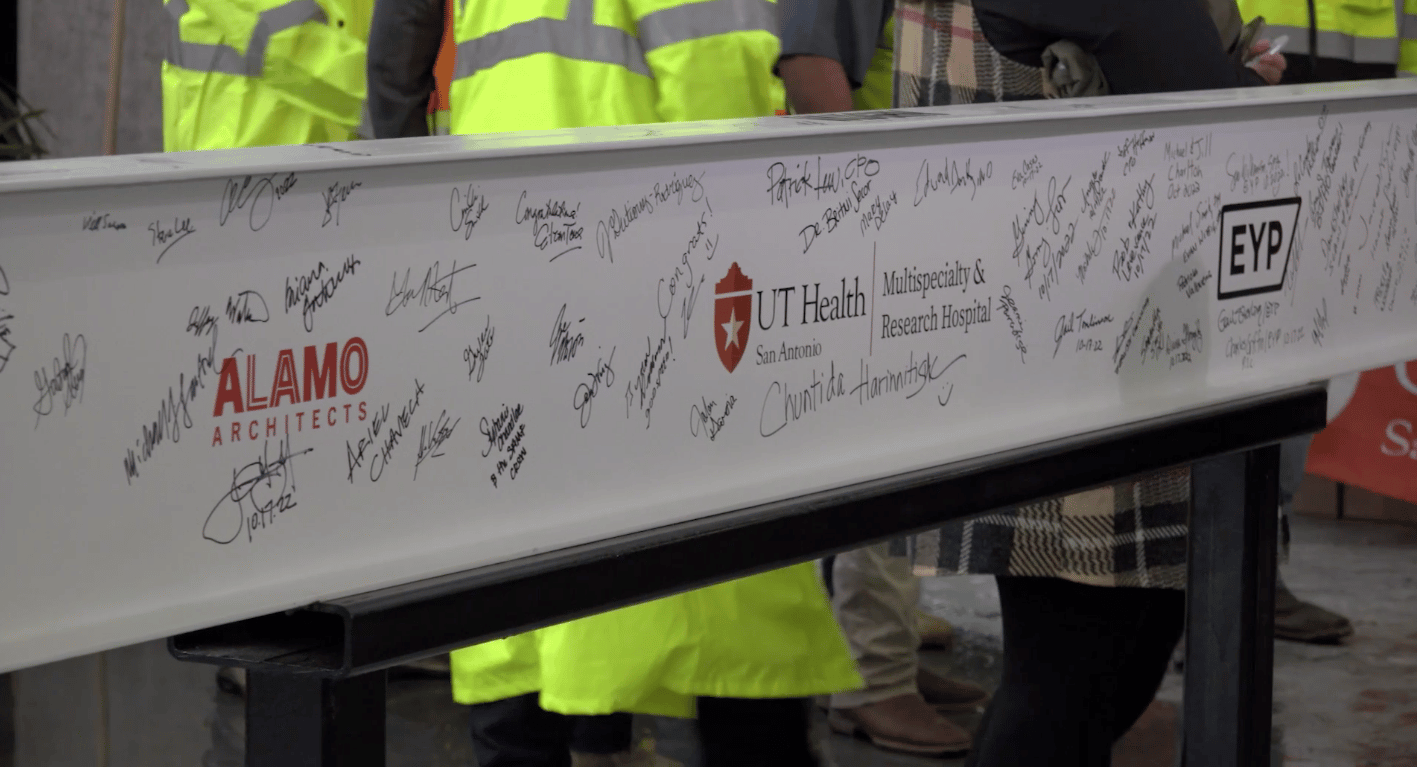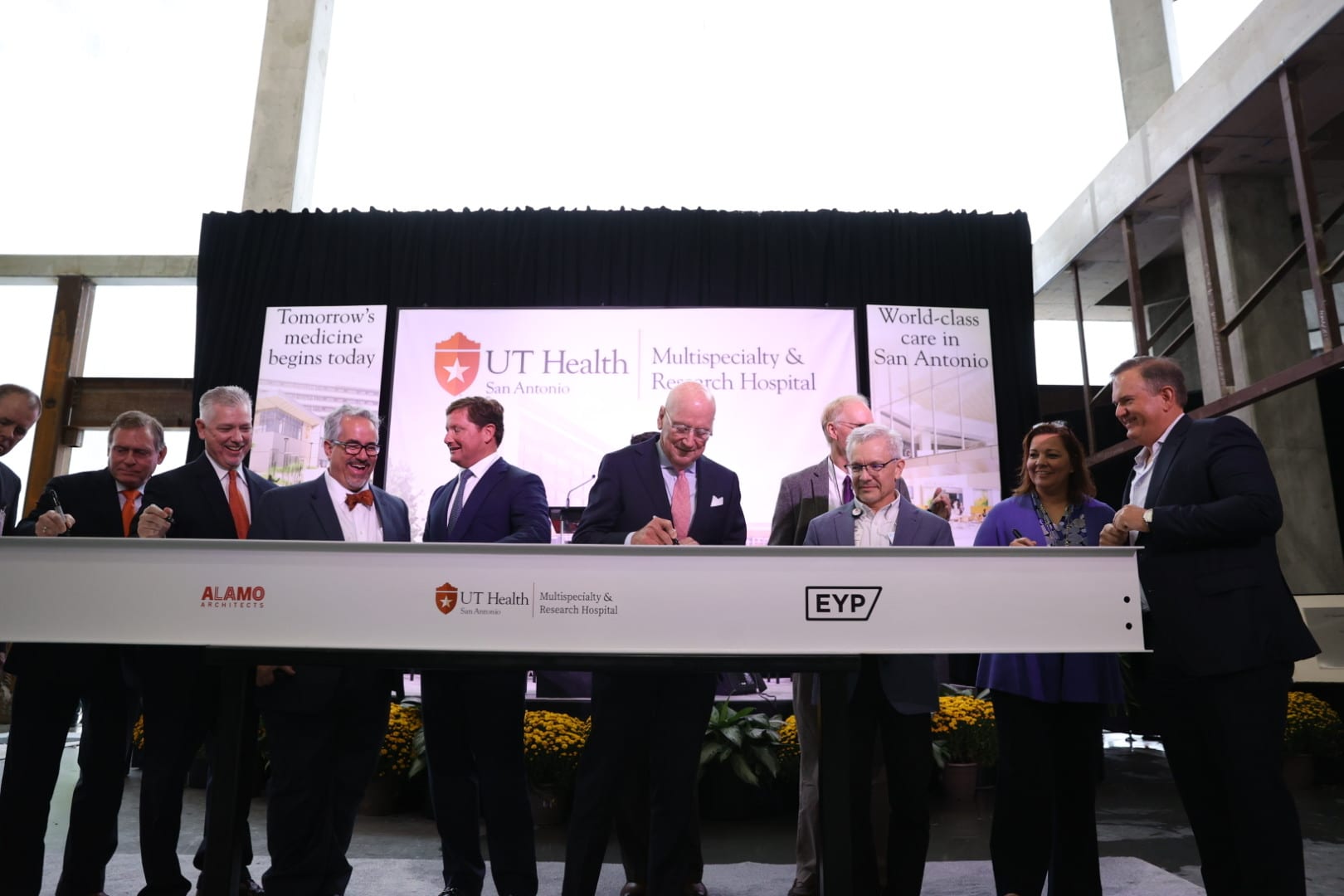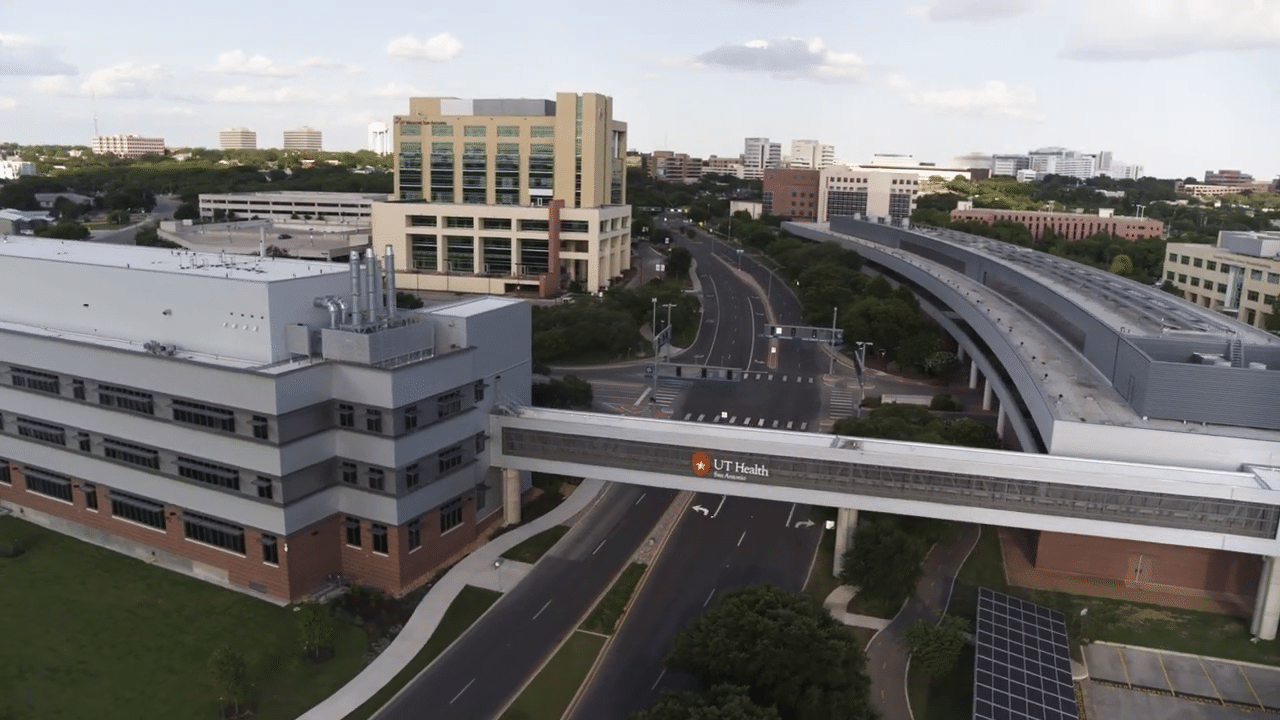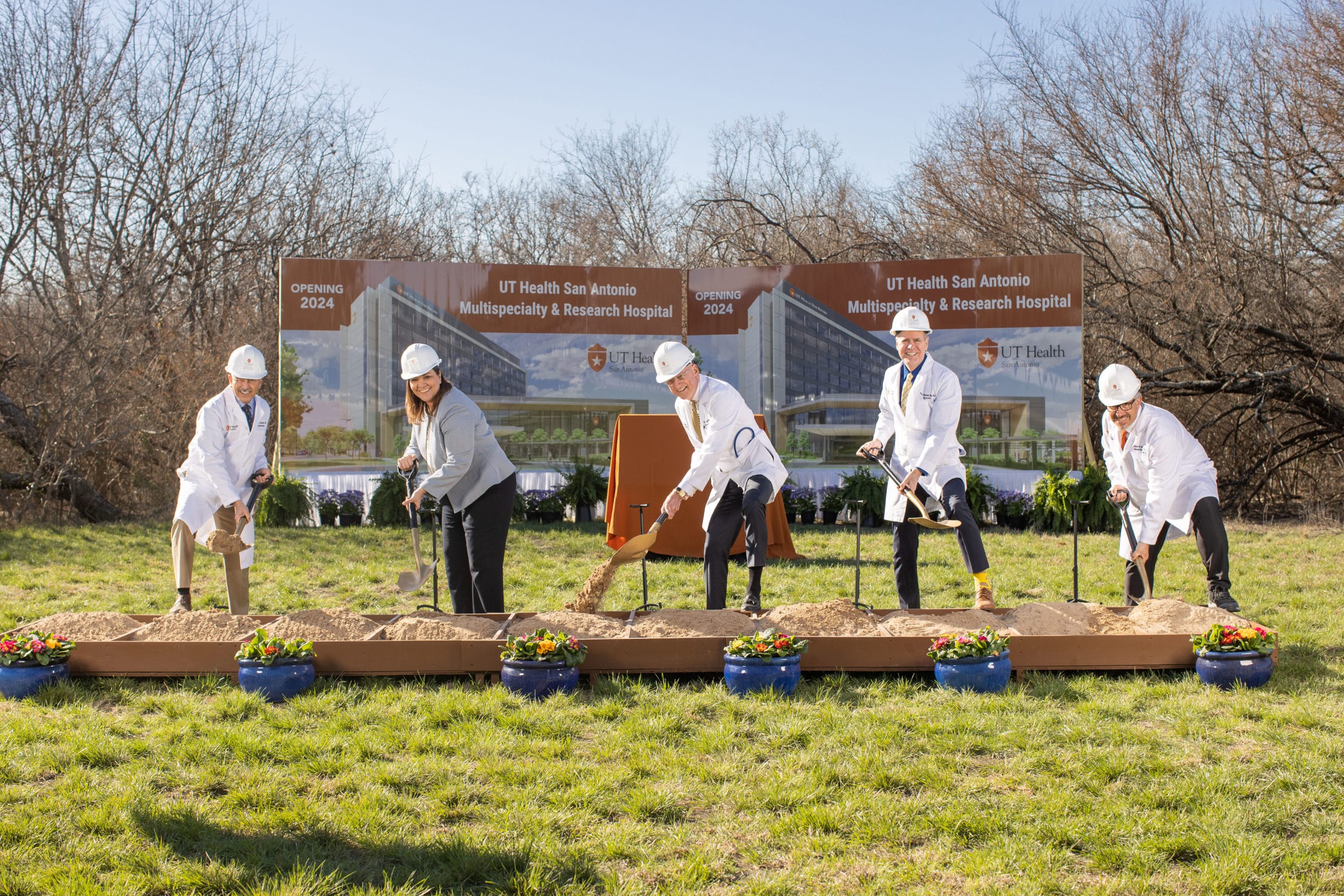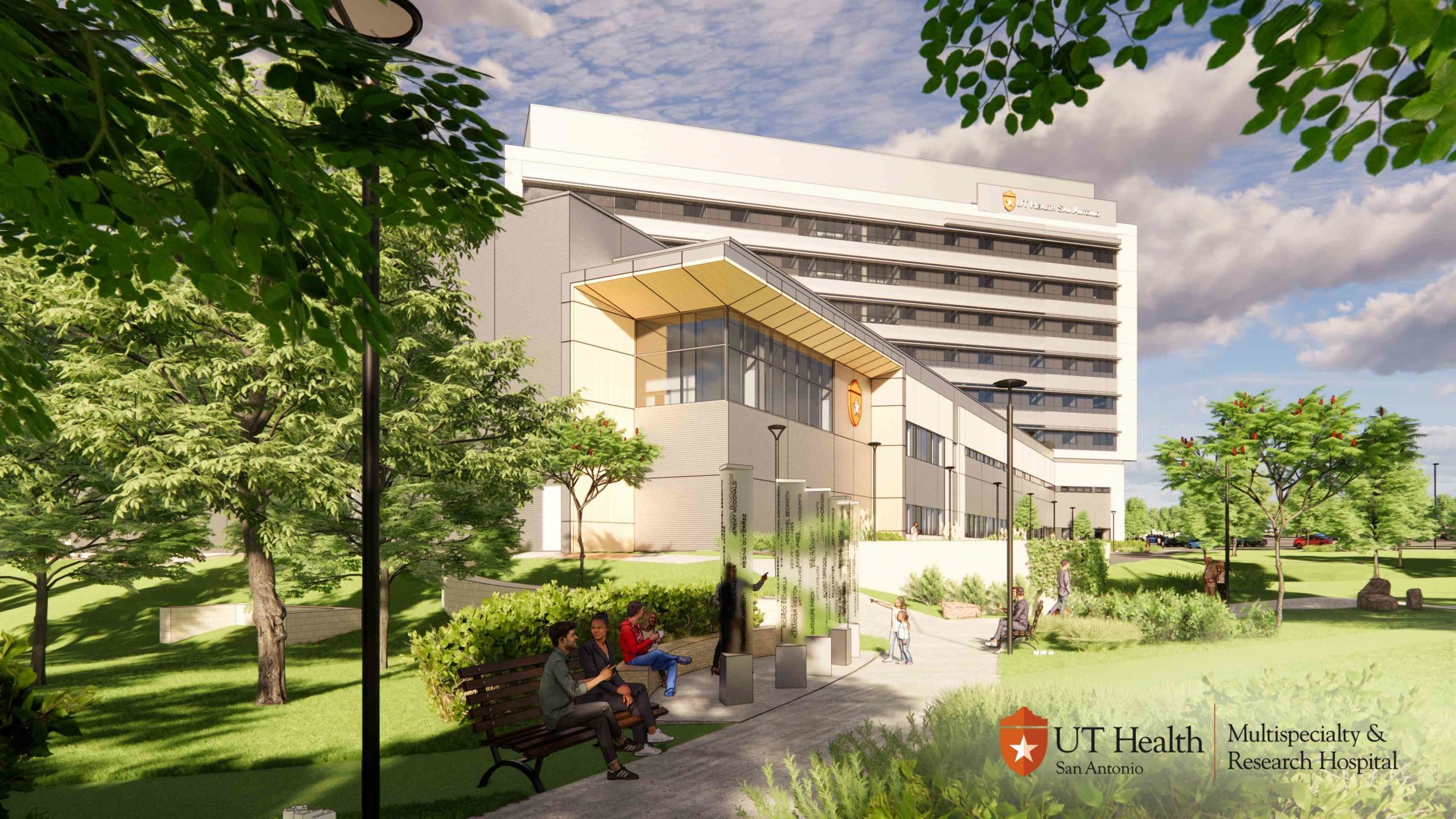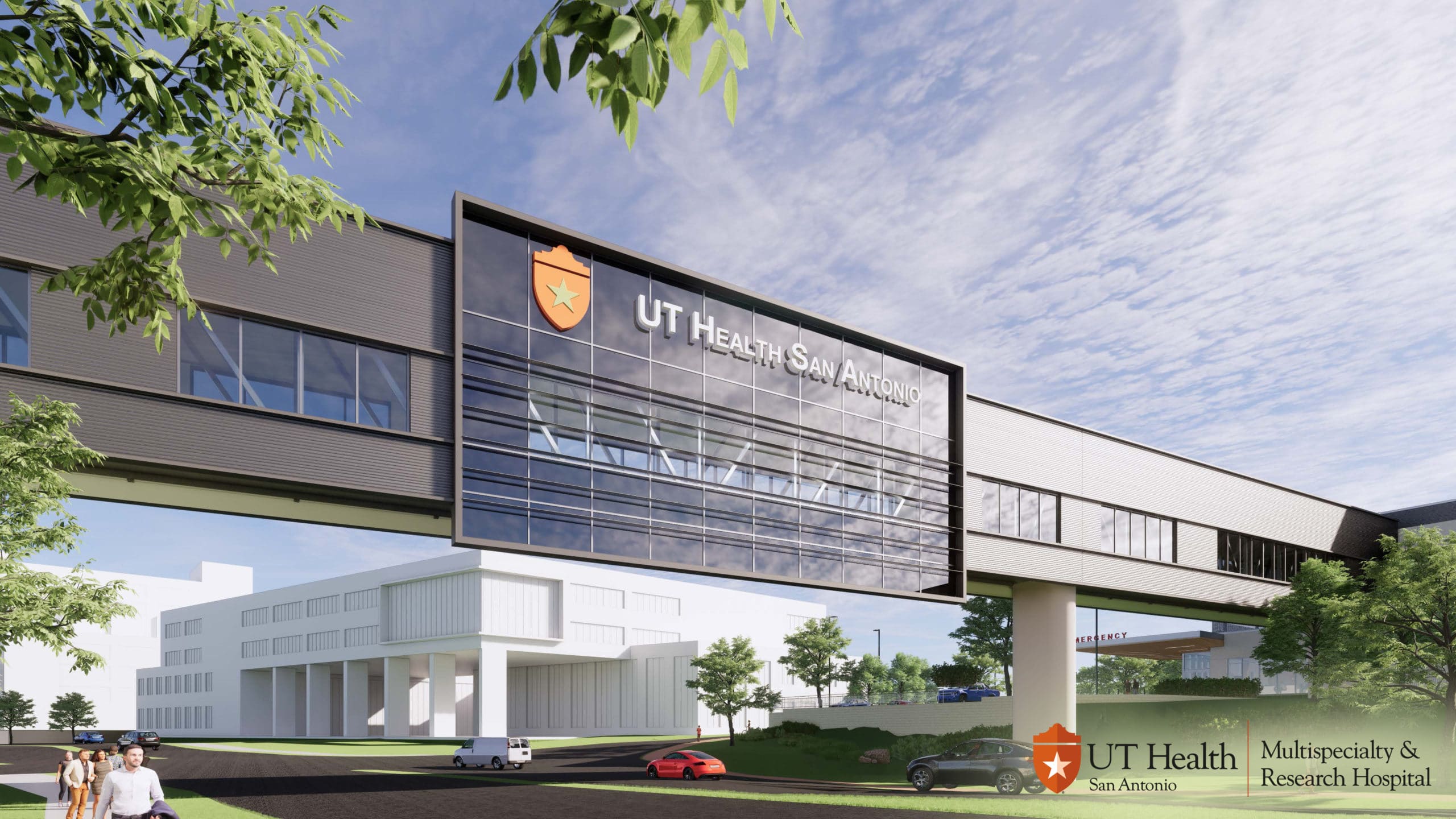Video News Release: UT Health San Antonio Multispecialty & Research Hospital “Topping Out” and Beam-Signing Ceremony
This VNR includes footage from the UT Health San Antonio Multispecialty & Research Hospital” Topping Out” and Beam-Signing Ceremony, plus interviews with University leaders. Details appear on video slates.
Leaders celebrate topping out of UT Health San Antonio Multispecialty and Research Hospital
Half-a-billion-dollar hospital will be unique for specialized care, new services to the region and clinical trials in a patient-centered atmosphere.
Media contact: Will Sansom, 210-567-2579, sansom@uthscsa.edu
Monica Taylor, 210-508-2488, taylorm1@uthscsa.edu
SAN ANTONIO (Oct. 17, 2022) — Surgeries in multiple specialties, new services for the region including stem cell therapies and bone marrow transplants, and access to the latest clinical research trials are drawing closer to reality as construction of the half-a-billion-dollar UT Health San Antonio Multispecialty and Research Hospital reaches an important milestone in the South Texas Medical Center.
Video News Release: UT Health San Antonio Multispecialty & Research Hospital
This VNR includes footage from the UT Health San Antonio Multispecialty & Research Hospital virtual groundbreaking, plus interviews with University leaders and a patient of the Mays Cancer Center. Details appear on video slates.
‘An exciting day for health care in our region’
Cornerstone unveiled for $430 million UT Health San Antonio hospital
SAN ANTONIO, March 29, 2021 — The University of Texas Health Science Center at San Antonio has broken ground and unveiled the cornerstone for the UT Health San Antonio Multispecialty and Research Hospital, a destination center for research and treatment of cancer and other complex diseases that disproportionately impact the people of South Texas.
In a nod to the COVID-19 pandemic, the ceremony was held virtually.
William L. Henrich, MD, MACP, president of UT Health San Antonio, welcomed academic, civic and community leaders from The University of Texas System, the city of San Antonio and Bexar County. “This hospital represents an exciting day for health care in our region and carries our aspirations for UT Health San Antonio to lead a bright future propelled by science, education and clinical excellence,” Dr. Henrich said. Also joining the event were leaders from University Health, UT Health’s primary academic training site for more than 50 years.
The patient-centered hospital, to be built with state and private investments estimated at $430 million, will deliver the most advanced precision-based care and latest targeted therapies possible. “We are forging a future in which no patient will ever have to leave San Antonio to receive world-innovative treatments,” Dr. Henrich said. “This project will significantly and forever change how we serve the sickest and most vulnerable populations in our area.”
The eight-story, 144-bed hospital will offer specialty care in cancer, orthopedics, urology, and thoracic and bariatric surgery. Owned by The University of Texas, this new facility will be a major site for early phase clinical trials, including novel immunologic and stem cell therapies for cancer.
Chancellor James B. Milliken; John M. Zerwas, MD, executive vice chancellor for health affairs; and James C. “Rad” Weaver, vice chairman of the Board of Regents, represented The University of Texas System. In November 2019, the Board of Regents approved $80 million in Permanent University Fund Bond Proceeds for the project. The hospital is included in the UT System’s Capital Improvement Program.
“As a forward-thinking academic medical center, UT Health San Antonio will be the first in the region to leverage its vital academic, research and patient care missions to meet the growing demand for inpatient care of the most complex diseases impacting this diverse community,” Chancellor Milliken said.
“This new hospital will offer access to multispecialty services not available today,” Dr. Zerwas said. “Robust clinical trials will provide novel treatments and care options to families in their greatest hour of need. Predicting, preventing, treating and curing disease precisely will be the focus of the world-class physicians and other care providers who will serve here.”
“As a lifelong San Antonian, I firmly believe the people of our city deserve the very best health care that can be offered and that we should not have to seek this care outside of our city,” Regent Weaver said. “I applaud UT Health San Antonio’s leaders for their visionary actions to build this best-in-class hospital in our own city.”
David Zachry, chairman of the UT Health San Antonio Development Board, described the hospital’s impact on health care education.
“This new hospital will allow San Antonio to attract more than 50 new medical residents, many of whom will choose to stay in our community to raise their families and provide needed medical specialty care to our patients,” said Mr. Zachry, president and CEO of Zachry Construction Corp. “San Antonio is the seventh largest city in the United States, and this is an important and needed investment for everyone who lives and works in our wonderful city.”
Robert A. Hromas, MD, FACP, dean of the Joe R. and Teresa Lozano Long School of Medicine and vice president for medical affairs at UT Health San Antonio, praised the innovation in medical education, clinical care and research that the new hospital will foster.
“This new environment is being carefully designed to promote interprofessional collaboration as we provide exceptional care to patients and their families,” Dr. Hromas said. “This hospital is a crucial addition to our academic mission of producing new physicians and other health care providers. The hospital will help accelerate discoveries, validated in clinical trials, that bring improvements to clinical practice, resulting in the comprehensive advanced care we provide patients.”
The hospital will be connected by a pedestrian sky bridge to the Mays Cancer Center, home to UT Health San Antonio MD Anderson Cancer Center. The National Cancer Institute this year renewed its designation of the Mays Cancer Center as one of the elite cancer centers in the nation and one of only four NCI-designated Cancer Centers in Texas.
The emphasis on cancer care and research, symbolized by the sky bridge, will be strong. “NCI-designated Cancer Centers with superior access to state-of-the-art hospital care are the nation’s leaders in inpatient Phase I clinical trials of cellular-based therapies and surgical technologies,” said Ruben Mesa, MD, FACP, executive director of the Mays Cancer Center. “In addition, the seamless relationship between our outpatient clinics and inpatient hospital care will greatly benefit our patients.”
The hospital will also expand UT Health San Antonio’s partnership with University Health. UT Health San Antonio is working with University Health to form a top-tier integrated health delivery system to improve care throughout Bexar County. The new hospital will be complementary to existing programs at University Hospital, avoiding duplication of services.
“We are maturing our collaborative relationship with University Health into a well-integrated and aligned health network that can respond to San Antonio’s changing health care environment by providing high-quality, cost-efficient health care,” Dr. Hromas said. “We will continue to address inpatient demand, focus on specialized services needed by our diverse population, and design the future of health care for San Antonio and far beyond.”
“Our goal is to build upon our long and productive history of collaboration,” said George B. Hernández Jr., president and CEO of University Health. “Working together, we can create a healthier community, save and change lives, and lay a strong foundation for the next generation.”
Bexar County Judge Nelson W. Wolff praised the unparalleled effort of University Health and UT Health San Antonio in managing the increasing health care needs of the region — collaboration that is setting the partners’ collective work apart from other cities.
San Antonio Mayor Ron Nirenberg said the city will benefit by the hospital adding 800 high-quality jobs to the region. Dr. Henrich expressed gratitude to the San Antonio Medical Foundation, which stewards the Medical Center, for the gift of the site, 12.2 acres of land bordered by Ewing Halsell Drive, Wurzbach Road and Floyd Curl Drive.
The hospital raises the curtain on a new era of precision, personalized medicine based on innovative research conducted by San Antonians for San Antonians.
UT Health San Antonio will bring the expertise of 900 faculty specialists and subspecialists to serve patients and their families at this new facility. Patient care will be coordinated within a single, secure electronic medical record available anywhere 24/7.
“This investment is about far more than a new brick-and-mortar facility,” Dr. Henrich said. “This project will improve the way we serve our patients. We are proud to make this investment in our patients, our people and our community.”
The hospital design is 448,819 gross square feet and includes a 673-car parking garage and 200- car surface parking lot. EYP has been contracted to perform the architectural and engineering services, and the construction manager-at-risk is Vaughn Construction.
Construction is beginning this spring and is expected to be completed in 2024.
# # #
The Long School of Medicine at The University of Texas Health Science Center at San Antonio is named for Texas philanthropists Joe R. and Teresa Lozano Long. The school is the largest educator of physicians in South Texas, many of whom remain in San Antonio and the region to practice medicine. The school teaches more than 900 students and trains 800 residents each year. As a beacon of multicultural sensitivity, the school annually exceeds the national medical school average of Hispanic students enrolled. The school’s clinical practice is the largest multidisciplinary medical group in South Texas with 850 physicians in more than 100 specialties. The school has a highly productive research enterprise where world leaders in Alzheimer’s disease, diabetes, cancer, aging, heart disease, kidney disease and many other fields are translating molecular discoveries into new therapies. The Long School of Medicine is home to a National Cancer Institute-designated cancer center known for prolific clinical trials and drug development programs, as well as a world-renowned center for aging and related diseases.
The University of Texas Health Science Center at San Antonio, also referred to as UT Health San Antonio, is one of the country’s leading health sciences universities and is designated as a Hispanic-Serving Institution by the U.S. Department of Education. With missions of teaching, research, patient care and community engagement, its schools of medicine, nursing, dentistry, health professions and graduate biomedical sciences have graduated more than 37,000 alumni who are leading change, advancing their fields, and renewing hope for patients and their families throughout South Texas and the world. To learn about the many ways “We make lives better®,” visit www.uthscsa.edu.
Stay connected with The University of Texas Health Science Center at San Antonio on Facebook, Twitter, LinkedIn, Instagram and YouTube.
To see how we are battling COVID-19, read inspiring stories on Impact.
UT System Board of Regents approves design of UT Health San Antonio Multispecialty and Research Hospital
AUSTIN – The University of Texas System Board of Regents on Nov. 19 approved design development plans for the UT Health San Antonio Multispecialty and Research Hospital to be constructed on 12.2 acres of land in the South Texas Medical Center. The Board of Regents authorized expenditure of $398.8 million for the hospital from Revenue Financing System Bond Proceeds, Permanent University Fund Bond Proceeds, and gifts. With the addition of sundry items needed for hospital operations, the project total is at least $430 million. Primarily dedicated to cancer services, the eight-story, 144-bed hospital, to be located at the corner of Floyd Curl Drive and Wurzbach Road, will also accommodate specialties including neurosciences, orthopaedics, urology, thoracic surgery and bariatrics. The hospital will add 100 medical residents and fellows and 800 high-quality jobs for the city, and will offer advanced treatments through team-based care grounded in the latest medical research. UT Health San Antonio will bring the expertise of 1,000 faculty specialists and subspecialists to serve patients and their families. Patient care will be coordinated within a single, secure electronic medical record available anywhere 24/7.

“We are forging a future in which no patient will ever have to leave San Antonio to receive the most advanced, precision-based care,” said William L. Henrich, MD, MACP, president of UT Health San Antonio. “Therapeutic offerings in the new hospital will redefine medicine by focusing on predicting, preventing and curing disease precisely.”
Early phase clinical trials, including immunologic and stem cell therapies for cancer, will be a signature offering in the hospital. Some of the leading-edge therapies will originate from discoveries made in laboratories at UT Health San Antonio.
“Given our stature as the UT System’s flagship academic health center of South Texas, our unique mission blends medical education, research and patient care,” Dr. Henrich said. “Our patient-centered hospital will deliver the most advanced care possible because of our cutting-edge, internationally renowned research in complex diseases.”
The hospital will be connected by a sky bridge to the Mays Cancer Center, home to UT Health San Antonio MD Anderson. The National Cancer Institute this year renewed its designation of the Mays Cancer Center as one of the elite cancer centers in the nation and one of only four NCI-designated Cancer Centers in Texas.
UT Health San Antonio is working with University Health System (now referred to as University Health) to develop a top-tier integrated health delivery system to improve care throughout Bexar County. The new hospital complements University Health’s plans and will be highly complementary to existing programs at University Hospital, avoiding duplication of services. University Hospital, which is part of University Health, will continue to be the site of delivery for many leading regional programs, including trauma surgery, organ transplantation, and women’s and children’s services.
In November 2019, the Board of Regents approved $80 million in Permanent University Fund Bond Proceeds for the UT Health San Antonio Multispecialty and Research Hospital. The hospital is included in the UT System’s Capital Improvement Program.
The hospital design is 413,502 gross square feet and includes a 650-space parking garage. EYP has been contracted to perform the architectural and engineering services, and the construction manager-at-risk is Vaughn Construction.
Construction is expected to begin in the summer of 2021 and be completed in 2024.
# # #
The Long School of Medicine at The University of Texas Health Science Center at San Antonio is named for Texas philanthropists Joe R. and Teresa Lozano Long. The school is the largest educator of physicians in South Texas, many of whom remain in San Antonio and the region to practice medicine. The school teaches more than 900 students and trains 800 residents each year. As a beacon of multicultural sensitivity, the school annually exceeds the national medical school average of Hispanic students enrolled. The school’s clinical practice is the largest multidisciplinary medical group in South Texas with 850 physicians in more than 100 specialties. The school has a highly productive research enterprise where world leaders in Alzheimer’s disease, diabetes, cancer, aging, heart disease, kidney disease and many other fields are translating molecular discoveries into new therapies. The Long School of Medicine is home to a National Cancer Institute-designated cancer center known for prolific clinical trials and drug development programs, as well as a world-renowned center for aging and related diseases.
The University of Texas Health Science Center at San Antonio, also referred to as UT Health San Antonio, is one of the country’s leading health sciences universities and is designated as a Hispanic-Serving Institution by the U.S. Department of Education. With missions of teaching, research, patient care and community engagement, its schools of medicine, nursing, dentistry, health professions and graduate biomedical sciences have graduated more than 37,000 alumni who are leading change, advancing their fields, and renewing hope for patients and their families throughout South Texas and the world. To learn about the many ways “We make lives better®,” visit www.uthscsa.edu.
A Bold Vision: UT Health San Antonio Multispecialty and Research Hospital
Our vision is to create a research and specialty hospital that is home to leading-edge care for patients with the most complex conditions and where discovery is translated into effective new therapy. It will also be a place for training the next generation of superb health care providers for our region and beyond.
From leading-edge clinical trials, to complex, inpatient specialty care, we will offer the best and newest technologies in a “healing advantage” that combines science and innovation with compassion. We will deliver precision health care in an environment where patients always come first.
UT Health San Antonio is the only academic health science center serving San Antonio and our 38-county region of 5 million people. San Antonio is the 7th largest city in the U.S. and among the fastest growing cities in the nation, increasing by more than 2,000 residents every month. Our highly diverse and aging population faces a disproportionate prevalence of cancer, neurodegenerative disease, diabetes, heart disease and other complex conditions. These conditions, in turn, require the most sophisticated care in oncology, radiation therapy, neurology and orthopedics, to name just a few disciplines. In addition, there is a growing need for enhanced access to leading-edge clinical trials in San Antonio, and this hospital will provide the research expertise to accomplish this goal.
Since being established over 50 years ago, we have been affiliated principally with University Hospital, our primary teaching hospital, and we will continue this partnership in the future. Services established in the new UT Health Multispecialty and Research Hospital will be complementary to services in University Hospital. An important goal is to reduce fragmented patient care in a more seamless system of care.
UT Health San Antonio has earned its distinction as a “rising star” among academic medical centers, both in Texas and the nation. UT Health San Antonio stands at the center of a $42 billion regional healthcare and biosciences effort. Our mission is comprehensive: biomedical research, patient care, medical education, and community health. We are attracting top-ranked, nationally recognized investigators and clinicians to our community and delivering cutting-edge therapies and resources that other health facilities do not provide. We offer excellence in education for medical, nursing, health professions, biomedical science and dental students, and we train more than 1,000 medical residents annually for our community. We are a “research intensive” University with approximately $300 million in annual research support. This distinguished record documents the unique contributions UT Health San Antonio makes to the health of our community and region.
The UT System Board of Regents has allocated $80 million for this transformative project, a generous pledge of their commitment to UT Health and to the community of San Antonio. In addition, UT Health has pledged $20 million toward the $430 million project cost. We are embarking on a Campaign to raise at least $70 million in philanthropy and every gift we receive, up to $100 million, will be matched. The remainder of the project will be financed.
Goals for UT Health San Antonio Multispecialty and Research Hospital
- Build a best in class hospital that is #1 in San Antonio, for our community and South Texas;
- Offer leading-edge, high quality, precision patient care translated from the latest research;
- Provide comprehensive cancer care in a state-of-the-art facility by a multidisciplinary team, animated by state-of-the-art technology and innovation;
- Conduct hospital-based clinical trials and treatments not currently offered in this area — immunotherapies, stem cell transplant, cellular-based therapies — that greatly expand treatment options for our patients;
- Elevate UT Health San Antonio to the status of a “flagship” of the UT Health System;
- Make it unnecessary for any patient to have to leave San Antonio for the most sophisticated patient care available anywhere in the world;
- Aim to break ground in Spring 2021 and open the hospital in 2024
Key Features of UT Health San Antonio Multispecialty and Research Hospital
- 144-bed, 8-floor hospital connected to the Mays Cancer Center by a climate-controlled skybridge;
- 12-acre site in South Texas Medical Center with hospital, parking garage and flexible, adaptable design to accommodate future growth;
- Immunotherapy and stem cell unit with cancer focused care and include other services such as urology and orthopedics;
- 12 operating rooms, ICU, clinical trials, emergency department, pharmacy, laboratories, and Nuclear Medicine, CT, MRI and X-ray Imaging Center;
- 750 new jobs and 150 new training slots for residents.
UT Health San Antonio hospital will heighten hope for cancer patients
The UT Health San Antonio Multispecialty and Research Hospital is an exciting new venture for the people of South Texas. This $430 million investment will provide our region with a unique pathway to health – intricate, specialty care using innovative technologies and clinical trials not available anywhere else.
While adding 100 medical residents and fellows to our practice and 800 jobs for our city, this hospital will offer best-in-class, holistic, team-based care grounded in the latest medical research. UT Health San Antonio will bring the expertise of 1,000 faculty specialists and subspecialists to bear on every patient who enters our doors. Patient care will be coordinated within a single electronic medical record.
We are forging a future in which no patient will ever have to leave San Antonio to receive the most advanced, precision-based care that redefines medicine as it focuses on predicting, preventing and curing disease precisely.
Given our stature as the UT System’s flagship academic health center of South Texas, our unique mission blends medical education, research and patient care. Our patient-centered hospital will deliver the most advanced care possible because of our cutting-edge, internationally renowned research in complex diseases.
We will do this by taking the laboratory breakthroughs our scientists discover and translating them into effective new therapies for diseases that disproportionately affect the people of our community, including our military and senior retirees and Hispanic population.
The best example of our research into complex diseases is cancer, the economic burden of which is expected to increase by 34 percent nationally by 2030. Tragically, despite many advances, our region’s cancer burden continues to be significant. But, fortified by the university’s nationally leading physicians in oncology, our hospital’s patients will be able to receive the most advanced cancer care, including new drugs, novel cell therapies, and innovative surgical techniques and devices.
The hospital will help us respond to our region’s cancer need, as 75 percent of its beds will be devoted to cancer care. The hospital will be connected by a sky bridge to the Mays Cancer Center, home to UT Health San Antonio MD Anderson. The National Cancer Institute this year renewed its designation of the Mays Cancer Center as one of the elite cancer centers in the nation and one of only four NCI-designated Cancer Centers in Texas.
We have received tremendous community support for our hospital, and we are excited that our clinical partner of 52 years, University Health System, has agreed to join us in this endeavor. We intend for the hospital to be highly complementary to existing programs at University Hospital with no duplication of services. University Hospital will continue to be the site of delivery for many leading regional programs, including trauma surgery, organ transplantation, and women’s and children’s services.
We are grateful that The University of Texas System Board of Regents approved $80 million for the hospital. We are also appreciative of the San Antonio Medical Foundation, which donated 12.2 acres of land in the South Texas Medical Center.
In August the Board of Regents endorsed the launch of the hospital’s design and development phase. A rendering will be presented to the Board for approval in November to move forward with construction.
This important beacon of health care will take approximately three years to build and, when complete, will serve the many cancer patients of our region through new treatments and “rescue therapies.” A greater number of stellar physicians and health care professionals will meet the needs of our community in the finest research hospital in the country.
William L. Henrich, MD, MACP, is president of UT Health San Antonio. Robert A. Hromas, MD, FACP, is dean of the university’s Joe R. and Teresa Lozano Long School of Medicine.
